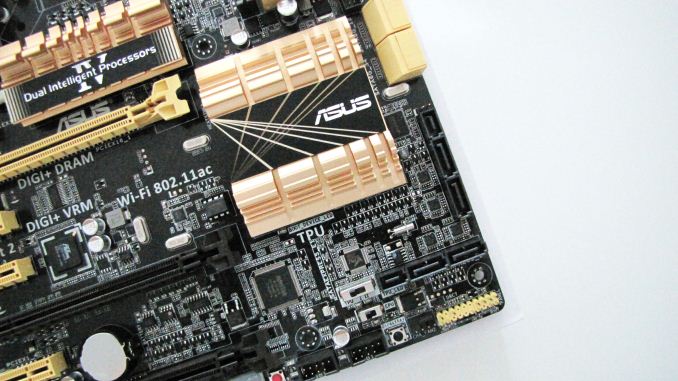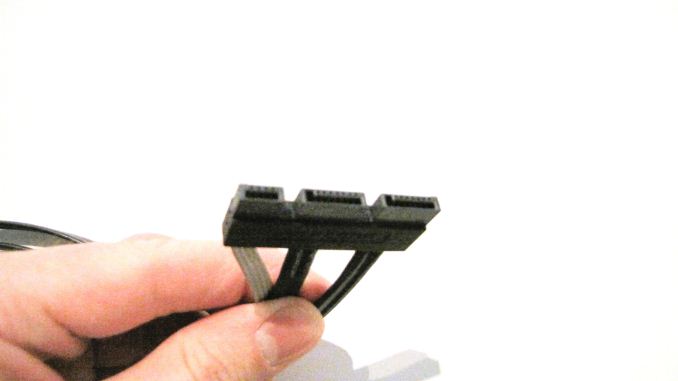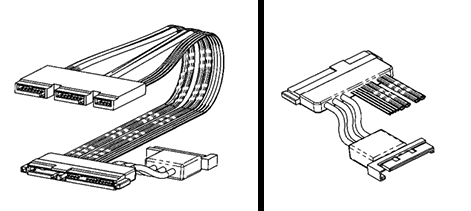Testing SATA Express And Why We Need Faster SSDs
by Kristian Vättö on March 13, 2014 7:00 AM EST- Posted in
- Storage
- SSDs
- Asus
- SATA
- SATA Express
What Is SATA Express?
Officially SATA Express (SATAe from now on) is part of the SATA 3.2 standard. It's not a new command or signaling protocol but merely a specification for a connector that combines both traditional SATA and PCIe signals into one simple connector. As a result SATAe is fully compatible with all existing SATA drives and cables and the only real difference is that the same connector (although not the same SATA cable) can be used with PCIe SSDs.
As SATAe is just a different connector for PCIe, it supports both the PCIe 2.0 and 3.0 standards. I believe most solutions will rely on PCH PCIe lanes for SATAe (like the ASUS board we have), so until Intel upgrades the PCH PCIe to 3.0, SATAe will be limited to ~780MB/s. It's of course possible for motherboard OEMs to route the PCIe for SATAe from the CPU, enabling 3.0 speeds and up to ~1560MB/s of bandwidth, but obviously the PCIe interface of the SSD needs to be 3.0 as well. The SandForce, Marvell, and Samsung designs are all 2.0 but at least OCZ is working on a 3.0 controller that is scheduled for next year.
The board ASUS sent us has two SATAe ports as you can see in the image above. This is a similar port that you should find in a final product once SATAe starts shipping. Notice that the motherboard connector is basically just two SATA ports and a small additional connector—the SATA ports work normally when using a standard SATA cable. It's only when the connector meets the special SATAe cable that PCIe magic starts happening.
ASUS mentioned that the cable is not a final design and may change before retail availability. I suspect we'll see one larger cable instead of three separate ones for esthetic and cable management reasons. As there are no SATAe drives available yet, our cable has the same connector on both ends and the connection to a PCIe drive is provided with the help of a separate SATAe daughterboard. In the final design the other end of the cable will be similar to the current SATA layout (data+power), so it will plug straight into a drive.
That looks like the female part to the SATA connector in your SSD, doesn't it?
Unlike regular PCIe, SATAe does not provide power. This was a surprise for me because I expected SATAe to fully comply with the PCIe spec, which provides up to 25W for x2 and x4 devices. I'm guessing the cable assembly would have become too expensive with the inclusion of power and not all SATA-IO members are happy even with the current SATAe pricing (about $1 in bulk per cable compared to $0.30 for normal SATA cables). As a result, SATAe drives will still source their power straight from the power supply. The SATAe connector is already quite large (about the same size as SATA data + power), so instead of a separate power connector we'll likely see something that looks like this:
In other words, the SATAe cable has a power input, which can be either 15-pin SATA or molex depending on the vendor. The above is just SATA-IO's example/suggestion—they haven't actually made any standard for the power implementation and hence we may see some creative workarounds from OEMs.















131 Comments
View All Comments
SirKnobsworth - Thursday, March 13, 2014 - link
Thunderbolt 2 is really PCIe x4 + DisplayPort in disguise, and you don't need DisplayPort to your SSD.MrSpadge - Thursday, March 13, 2014 - link
Couldn't you build a nice M.2 to SATAe adapter in a 2.5" form factor and thereby reuse your existing M.2 designs for SATAe?Kristian Vättö - Thursday, March 13, 2014 - link
Technically yes, but the problem is that M.2 is shaped differently. You could certainly fit a small M.2 drive with only few NAND packages in there but the longer, faster ones don't really fit inside 2.5".Kevin G - Thursday, March 13, 2014 - link
"At 24 frames per second, uncompressed 4K video (3840x2160, 12-bit RGB color) requires about 450MB/s of bandwidth, which is still (barely) within the limits of SATA 6Gbps."This is incorrect:
3840 * 2160 * 12 bit per channel * 3 channels / 8 bits per byte * 24 fps ~ 896 MByte/s
And that figure is with with good byte packing. For raw recording, the algorithm may pack the 12 bits into two bytes for speed purposes meaning you'd need about 1.2 Gbyte/s of bandwidth. Jumping to 4096 x 2160 resolution at 12 bit color and 30 fps, the bandwidth need grows to about 1.6 Gbyte/s.
The other thing worth noting is that uncompressed recording is going to take a lot of storage. A modern phone recording at the highest quality settings with 64 GB of storage would last less than 40 seconds before running out.
Kristian Vättö - Thursday, March 13, 2014 - link
Oh, you're absolutely right. I used the below calculator to calculate the bandwidth but accidentally left "interlaced" box ticked, which screwed up the results. Thanks for the heads up, fixing...Kristian Vättö - Thursday, March 13, 2014 - link
And the calculator... http://web.forret.com/tools/video_fps.asp?width=38...JarredWalton - Thursday, March 13, 2014 - link
Aren't there *four* channels, though? RGB and Alpha? Or is Alpha not used with 12-bit?Kevin G - Thursday, March 13, 2014 - link
No real way to record with an Alpha channel value to my knowledge. Cameras and scanners etc all presume a flattened image as if everything were solid. The only exception to this would be direct frame buffer capture from video memory which can independently process an Alpha channel.Input media would generally be 36 bit. During the editing phase an Alpha channel can be added as part of compositing pipeline bringing the total bit depth to 48 bit. Final rendering can be done to a 48 bit RGBA file. Display output on screen will be reduced to 36 bit due to compositing for the frame buffer.
Nightraptor - Thursday, March 13, 2014 - link
When I saw the daughterboard Asus provided my instant thought was actually using this (in pcie 3.0 form) to somehow provide the option to add an external GPU to a tablet. I may be the outlier, but my dream would be to have and 11.6" 16:10 1920 x 1200 tablet with the ability to connect a keyboard dock to function as a laptop, or another dock with a discrete graphics card to function as a desktop for occasional gaming (1080p at high setting would be all I'd ask for - so pcie 3.0 4x should be sufficient). If you could somehow get a SATAe cable on a tablet I think this would do it.vladman - Thursday, March 13, 2014 - link
If you want speed from storage, get a nice Areca PCIe RAID controller, attach 4 or more fast SSDs, do RAID 0, and you've got anywhere from 1.7 to 2GB/s of data transfer. Done deal.